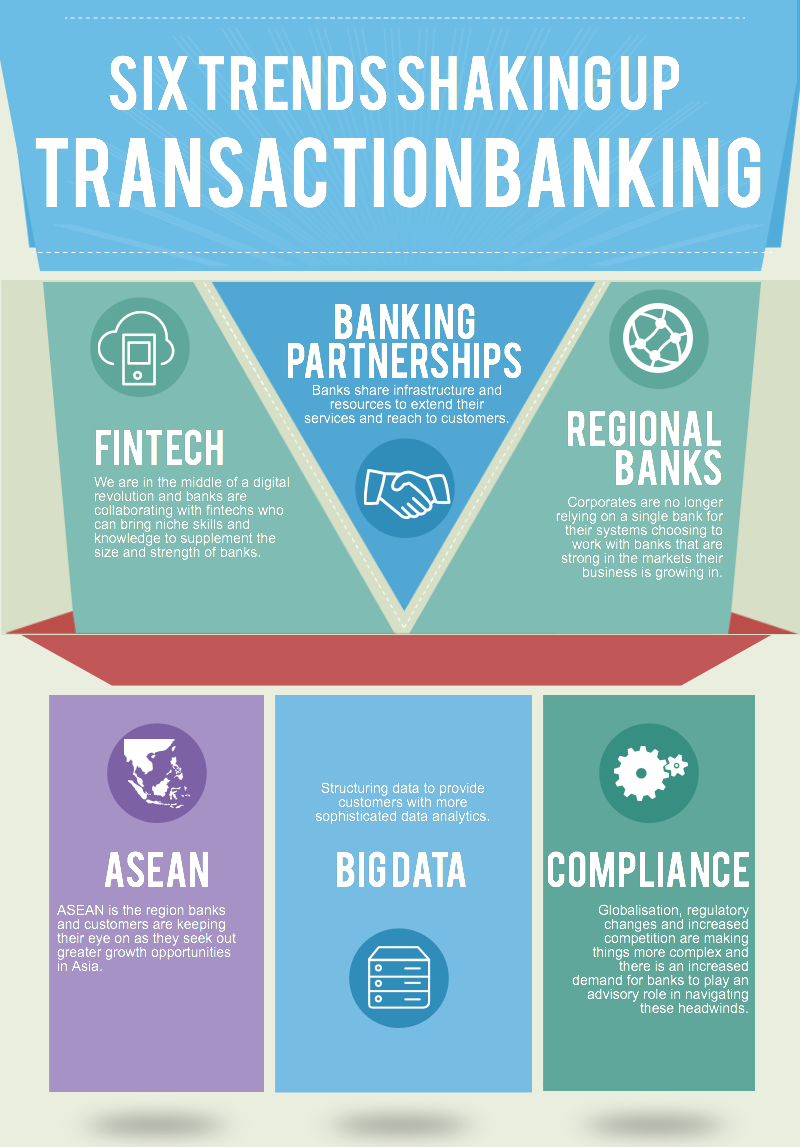-
SIBOS, the Swift International Banking Operations Seminar, one of the largest annual conference and networking events for the financial industry has recently wrapped in Singapore, the first time the event has been held in Asia for six years.
It was an opportune time. Despite immediate conditions, Asia will be the centre for business growth, trade and investment flows for banks and corporates for decades to come.
"Despite the buzz on technology, everyone is still trying to make sense of what this means for their customers and their business."
Carole Berndt, Head of Global Transaction Banking at ANZSIBOS has always served as a pulse-check on the transaction banking beat. I was at the event and the conversations showed the vibe in the transaction banking community is vibrant and positive. Here are the key trends I saw shaping the future of transaction banking.
{CF_IMAGE}
FINTECH
We are in the middle of a digital revolution, evident in the rise of fintech companies and technologies. For the first time, new technology such as Blockchain and Cloud based solutions were very visible at SIBOS and technology was the most talked about topic everywhere you went.
Despite the buzz on technology, everyone is still trying to make sense of what this means for their customers and their business. Fintechs have forced banks to look at the competitive environment in a completely new way and banks are working out how they can make this work for them.
Ultimately, fintechs rely on banks for basic banking infrastructure so banks should leverage this to form partnerships with fintechs who can bring niche skills and knowledge to supplement the size and strength of banks.
A number of banks, ANZ included, have set up innovation labs to collaborate with fintechs and other technology partners in designing and testing new solutions.
BANKING PARTNERSHIPS
Many of the global and regional banks noted the correspondent banking model is at its tipping point. This is driven by a demand for faster processing, increased transparency and appropriate pricing of services.
This has sparked renewed interest in the bank alliance model, where banks share infrastructure and resources to extend their services and reach to customers.
I foresee a model similar to alliances in the airlines model, where banks work closely to create a better experience for customers while focussing on their strengths and relying on other banks for areas they don't have geographic or product reach. However, the debate is still out on when this change will take place.
REGIONAL BANKS
A new focus this year was on how regional banks are emerging as the right model for an increasing number of corporates, balancing the need for depth of capability, risk management, consistency and local flexibility. This shift appears to be happening n at the expense of global and local banks.
Many corporates are already building their technology infrastructures so they no longer rely on a single bank for their systems. They now choose to work with banks that are strong in the markets their business is growing in.
Corporate treasurers also prefer to diversify risk by having a number of banking partners instead of just one. As a super regional Asia Pacific focussed bank, we believe ANZ's network and capabilities are well matched to the ambitions of companies expanding in the region.
ASEAN
ASEAN is the region banks and customers are keeping their eye on as they seek out greater growth opportunities in Asia. ANZ recently launched a white paper outlining three important opportunities for banks and companies in the region.
Firstly, the rise of the Mekong frontier; Cambodia, Laos, Myanmar and Vietnam are expected to grow so rapidly by 2025 their combined economies will be larger than Malaysia.
Secondly, more harmonised banking regulations across ASEAN as a result of bilateral treaties.
Thirdly, there is an opportunity for companies to bypass the $US for more liquid, direct ASEAN foreign currency pairs.
These benefits will materialise in the long term but the excitement is evident as banks and corporates align themselves with these opportunities by expanding their footprint, such as ANZ's new Myanmar branch, and seeking out partners in the region.
BIG DATA
Corporates were very vocal in saying data is theirs and they want it. Structuring data to provide analytics and value was core to many conversations.
Many banks are in discussions with vendors to provide customers with more sophisticated data analytics that can be blended with the customer's own internal information to offer meaningful insights on improving business efficiency.
There is also a demand for peer group metrics which can be maximised through centralised partnerships such as SWIFT KYC. However the opportunity will only grow only if banks are prepared to put their data in to the register without concern for competition.
COMPLIANCE
Compliance continued to be a key discussion point, even though some of the attention was diverted to fintech.
Globalisation, regulatory changes and increased competition are making things more complex and corporates are uncertain how to deal with regulatory environments and changing geographic landscapes. There is an increased demand for banks to play an advisory role in navigating these headwinds.
Customers are also taking a closer look at how banks are managing their investments and technology to ensure they are compliant.
Carole Berndt is Head of Global Transaction Banking at ANZ
The views and opinions expressed in this communication are those of the author and may not necessarily state or reflect those of ANZ.
-
anzcomau:Bluenotes/business-finance,anzcomau:Bluenotes/business-finance/banking,anzcomau:Bluenotes/business-finance/innovation,anzcomau:Bluenotes/business-finance/opinion,anzcomau:Bluenotes/business-finance/fintech
Six trends shaking up transaction banking
2015-10-28

